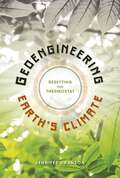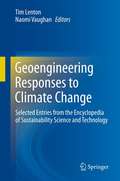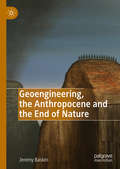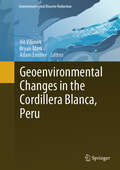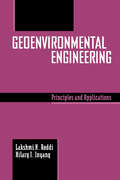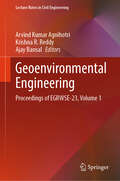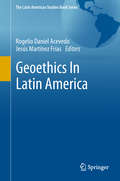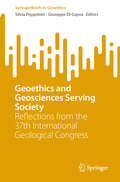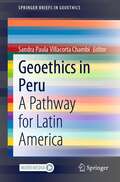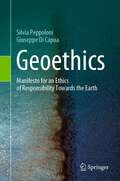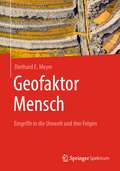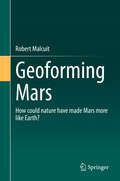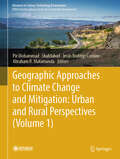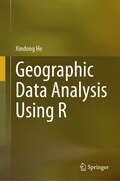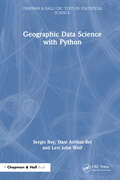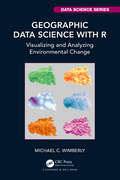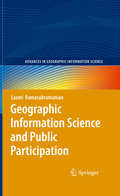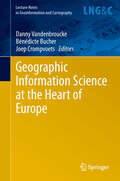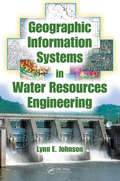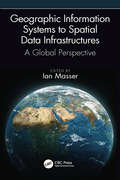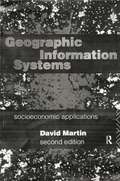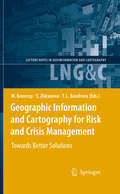- Table View
- List View
Geoeconomics of the Sustainable Development Goals (Frontiers of Geoeconomics, Geopolitics and Sustainability)
by Bernadette Andreosso-O’Callaghan Lucía Morales Daniel RajmilIn 2015, the United Nations introduced its very ambitious 2030 Agenda, known as the Sustainable Developmental Goals or SDGs. The SDGs provide a comprehensive list of goals and targets to address social, economic and environmental issues. In this book, different areas of expertise are brought together, examining the main challenges associated with the effects of “climate change” and the broader scope of the SDGs through the lenses of the geo-economics and geopolitics of sustainability. The book sheds light on the growing connections between the economic and financial fields and their impact on defining the international order and its economy. It examines the importance of trade and economic integration in promoting sustainable development and achieving the SDGs.The role of supranational organisations like the United Nations, the World Trade Organisation and the IMF in supporting the SDGs within the context of the world’s most advanced economies and those less developed; the influence of economic diplomacy and geopolitical rivalries on progress towards the SDGs; the changing global balance of power and the significance of technology and innovation; as well as the role of emerging and less developed economies in enabling sustainable development. The book offers insights into practical issues linked to theory and applied frameworks, underscoring the significant challenges associated with sustainable development, the global economic and political reality, and how political tensions affect the global economy.The book supports students through the established disciplines of economics, finance, political science, and law and provides academics with new research and theory-building tools.
Geoengineering Earth's Climate: Resetting the Thermostat
by Jennifer SwansonMost scientists agree that Earth is warming rapidly. Glaciers are melting and rising seawaters are submerging islands and coastal cities. In the coming decades, millions will likely have to escape extreme weather caused by climate change. Some scientists say we need to act faster and with radical new technologies—now—to save our planet. They propose geoengineering, or "engineering Earth," to reset our global thermostat. Ideas include thickening clouds with chemicals to reduce the amount of sunlight and pulling carbon dioxide from the air with machines. However, critics say that geoengineering could backfire and create even worse weather. Is geoengineering too risky? Or is it our best hope of survival?
Geoengineering Responses to Climate Change
by Naomi Vaughan Tim LentonFailure by the international community to make substantive progress in reducing CO2 emissions, coupled with recent evidence of accelerating climate change, has brought increasing urgency to the search for additional remediation approaches. This book presents a selection of state-of-the-art geoengineering methods for deliberately reducing the effects of anthropogenic climate change, either by actively removing greenhouse gases from the atmosphere or by decreasing the amount of sunlight absorbed at the Earth's surface. These methods contrast with more conventional mitigation approaches which focus on reducing emissions of greenhouse gases, especially carbon dioxide. Geoengineering technologies could become a key tool to be used in conjunction with emissions reduction to limit the magnitude of climate change. Featuring authoritative, peer-reviewed entries from the Encyclopedia of Sustainability Science and Technology, this book presents a wide range of climate change remediation technologies.
Geoengineering, the Anthropocene and the End of Nature
by Jeremy BaskinThis book takes a critical look at solar geoengineering as an acceptable means for addressing climate change. Baskin explores the assumptions and imaginaries which animate ‘engineering the climate’ and discusses why this climate solution is so controversial. The book explains geoengineering’s past, its revival in the mid-2000s, and its future prospects including its shadow presence in the Paris climate accord. The main focus however is on dissecting solar geoengineering today – its rationales, underpinning knowledge, relationship to power, and the stance towards nature which accompanies it. Baskin explores three competing imaginaries associated with geoengineering: an Imperial imaginary, an oppositional Un-Natural imaginary, and a conspiratorial Chemtrail imaginary. He seeks to explain why solar geoengineering has struggled to gain approval and why resistance to it persists, despite the support of several powerful actors. He provocatively suggests that reconceptualising our present as the Anthropocene might unwittingly facilitate the normalisation of geoengineering by providing a sustaining socio-technical imaginary. This book is essential reading for those interested in climate policy, political ecology, and science & technology studies.
Geoenvironment, An Introduction
by U. AswathanaraynaThe focus of this book is on the management of the geoenvironment. It seeks to explain how, through an understanding of the environmental processes that take place in rocks, soils, waters, sediments, air and so on, the resources contained in them could be managed sustainably. Topics covered in the book include: Ecologically-sustainable industrial development; dynamics of the geoenvironment; the impact of mining on rocks, soils, water and biota; the natural radiation environment; the use of geotechnology to mitigate the consequences of natural disasters and the disposal of various kinds of waste, particulary hazardous waste. The models proposed by the World Bank on how to make environemntal amelioration economcially viable are also looked at.
Geoenvironmental Changes in the Cordillera Blanca, Peru (Geoenvironmental Disaster Reduction)
by Vít Vilímek Bryan Mark Adam EmmerThis book focuses on Peru’s highest and most glacierized mountain range – the Cordillera Blanca. This mountain range experienced numerous disasters in the past (e.g. lake Palcacocha outburst in 1941, earthquake-induced ice and rock avalanche from Mt. Huascarán in 1970) and has attracted the attention of researchers from around the world. The 15 chapters of the book span from broadly thematic topics of geology, geomorphology, climate, hydrology and hydrogeology, lakes, glaciation, and environmental settings to more specific topics and emergent themes of relevance for the Cordillera Blanca, including studies of various types of natural hazards (landslides, GLOFs). While most of the chapters focus on biophysical processes of the natural environment, several chapters explore the complex interactions between humans and environmental factors, providing insights and perspectives from social science and the humanities. This book offers an unprecedentedly comprehensive overview of the state-of-the-art knowledge about the geo-environmental changes in the Cordillera Blanca.
Geoenvironmental Engineering: Principles and Applications
by Hilary I. Inyang Lakshmi ReddiApplies science and engineering principles to the analysis, design, and implementation of technical schemes to characterize, treat, modify, and reuse/store waste and contaminated media. Includes site remediation.
Geoenvironmental Engineering: Proceedings of EGRWSE-23, Volume 1 (Lecture Notes in Civil Engineering #508)
by Krishna R. Reddy Arvind Kumar Agnihotri Ajay BansalThis book contains peer-reviewed and selected papers presented during the International Conference on Environmental Geotechnology, Recycled Waste Materials and Sustainable Engineering (EGRWSE) 2023, held at NIT Jalandhar. It discusses the recent innovations, trends, concerns, practical challenges encountered, and the solutions adopted in waste management and engineering, geotechnical and geoenvironmental engineering, infrastructure engineering and sustainable engineering. This book can serve as a useful resource for researchers, educators, policymakers, and professionals working in the field of civil engineering, chemical engineering, environmental sciences, and public policy.
Geoenvironmental and Geotechnical Issues of Coal Mine Overburden and Mine Tailings (Springer Transactions in Civil and Environmental Engineering)
by Krishna R. Reddy Sarat Kumar Das Lohitkumar Nainegali Surabhi JainThis contributed book edited by leading global experts focuses on the geoenvironmental and geotechnical issues of coal mine overburden and mine tailings and its unengineered dumping. It aims to provide knowledge-based information for diverse readers to assess, monitor, and manage coal mine overburden and mine tailings in various engineering applications while highlighting efficient solutions to reutilize the waste and conserve natural resources leading to sustainable development. The content also assesses mine backfilling, techniques to stabilize mine tailing storage facilities, mineral carbonation of mine tailings, landfill liners and barrier systems, reclamation of coal mine overburden, and geochemical, microbial, and environmental sustainability assessment, among others. This book is a useful resource for those in academia and industry.
Geoethics In Latin America (The Latin American Studies Book Series)
by Rogelio Daniel Acevedo Jesús Martínez FríasThis book studies geoethics in Latin America and offers comprehensive research on geoethics and geoeducation. Its respective chapters explore geoethics in relation to UNESCO geoparks, mining activities in Latin America, natural hazards and risk management. Geoethics is a key discipline in the field of Earth and Planetary Sciences, and not only includes scientific, technological, methodological and social-cultural aspects, but also addresses the need to consider appropriate protocols, scientific integrity issues and a code of good practice when studying the abiotic world.The position of Latin America’s recently created geoethics associations is based on protection of the environment, together with a reassurance that the balance of nature and the rights of human beings to enjoy it will be preserved.
Geoethics and Geosciences Serving Society: Reflections from the 37th International Geological Congress (SpringerBriefs in Geoethics)
by Silvia Peppoloni Giuseppe Di CapuaThis book explores diverse perspectives and practices in geoethics, offering a comprehensive overview of how ethical considerations are being integrated into the geosciences across disciplines and regions. It draws from the session &“Geoethics at the Heart of All Geoscience: Serving the Public Good&” held at the 37th International Geological Congress (IGC) in Busan, Republic of Korea. At the core of the discussion is geoethics - an integrated ethical framework for the geosciences. It provides geoscientists with guidance for responsible action in the face of complex global and societal challenges. By embracing their individual and collective responsibilities, geoscientists can play a key role in advancing human well-being and promoting the public good, while reshaping humanity&’s relationship with the Earth system. Contributors to this volume share insights and expertise, outline methodologies and strategies, raise critical questions, propose best practices, and present case studies that address the ethical, social, and cultural dimensions of geoscience. This diversity ensures a pluralistic, interdisciplinary approach that fosters dialogue and collaboration. Chapters are structured to build a coherent narrative, moving from foundational geoethical concepts to a wide range of applications, and culminating in the theme of diplomacy. Intended for a broad audience - including geoscientists, scholars across disciplines, humanists, social scientists, students, professionals, policymakers, journalists, and engaged citizens - this book invites reflection and action at the intersection of science, ethics, and society.
Geoethics in Peru: A Pathway for Latin America (SpringerBriefs in Geoethics)
by Sandra Paula Villacorta ChambiThe book discusses geoscience issues in Peru from a geoethical perspective, based on the leading experience of the Peruvian section of the International Association for Promoting Geoethics, in its seven years of activity.The introduction will present past and current activities to promote geoethics in Peru, such as the organization of the MinerLima exhibition (that has teaching purposes); the implementation of geoethics in georisk communication with vulnerable populations, as well as the promotion of adequate knowledge about national geological heritage. The other chapters will describe the main geoethical issues in Peru, related to georisk management and communication, mining, paleontology and geoheritage, geoducation. Some proposals for actions that should be taken to improve societal awareness and to make progress in problem-solving from a geoethical perspective will be discussed for each issue.In the final chapter Peruvian geoescience implications and new roles for geoscientists will be discussed, providing clues to their participation in the management of socio-environmental problems that affect Latin American region. It will be also underlined how geoethics represents a new theoretical and practical approach that may contribute in the current process to modernize geoscience education in Latin America.In this sense, this publication provides a solid base to apply the theoretical framework of Geoethics in Peru that may be suggested as an example to promote geoethics in other Latin American countries. As a result, the need to inform and prepare the population of growing countries such as Peru to face the problems of the modern world is evident.In order to attract more readers in Latin America, each chapter will be provided with a summary in Spanish.
Geoethics: Manifesto for an Ethics of Responsibility Towards the Earth
by Silvia Peppoloni Giuseppe Di CapuaThis book outlines the current development of geoethical thinking, proposing to the general public reflections and categories useful for understanding the ethical, cultural, and societal dimensions of anthropogenic global changes. Geoethics identifies and orients responsible behaviors and actions in the management of natural processes, redefining the human interaction with the Earth system based on a critical, scientifically grounded, and pragmatic approach. Solid scientific knowledge and a philosophical reference framework are crucial to face the current ecological disruption. The scientific perspective must be structured to help different human contexts while respecting social and cultural diversity. It is impossible to respond to global problems with disconnected local actions, which cannot be proposed as standard and effective operational models. Geoethics tries to overcome this fragmentation, presenting Earth sciences as the foundation of responsible human action toward the planet. Geoethics is conceived as a rational and multidisciplinary language that can bind and concretely support the international community, engaged in resolving global environmental imbalances and complex challenges, which have no national, cultural, or religious boundaries that require shared governance. Geoethics is proposed as a new reading key to rethinking the Earth as a system of complex relationships, in which the human being is an integral part of natural interactions.
Geofaktor Mensch: Eingriffe in die Umwelt und ihre Folgen
by Diethard E. Meyer„Lässt sich die Erde retten? Sicherlich nicht mit einem neuen Buch wie diesem - aber es kann helfen, die Umweltprobleme besser zu verstehen!“ Der Aufstieg des Menschen zur wirksamsten geologischen Kraft auf dem Planeten Erde - kurz „Geofaktor Mensch“ genannt - vollzog sich allmählich. Im Industriezeitalter steigerte sich diese Kraft enorm durch neue Techniken. Diese ermöglichten die Inanspruchnahme fast sämtlicher Georessourcen für eine obendrein dramatisch anwachsende Menschheit, die weiterhin weltweit nach einem höheren Lebensstandard strebt. Kaum ein Gebiet der Erde bleibt verschont. Diese anthropogenen Eingriffe in das Naturgeschehen sind in vielfacher Hinsicht einzigartig - sowohl in ihrem Umfang als auch in ihrer Qualität. Seit kurzem wird dieser neuartige Zeitabschnitt in der Geschichte unseres Planeten als das „Anthropozän“ bezeichnet. Anschaulich und mit vielen Fotos und Diagrammen belegt dieses Werk das teilweise höchst komplexe Zusammenspiel der menschlichen Eingriffe in Natur und Umwelt. Zunächst schleichend, dann aber sehr plötzlich kann dieses an bestimmten „Kipp-Punkten“ zu anthropogen induzierten Katastrophen führen. Und genau diese gilt es von vornherein durch wissenschaftlich fundierte Planung unter strikter Kontrolle bei sich verändernden Rahmenbedingungen zu verhindern. Für Geowissenschaftler, Ökologen, Ingenieure und Landschaftsarchitekten sowie alle Tätigen in der Landschaftsplanung oder im Umwelt- und Naturschutz und nicht zuletzt die Entscheidungsträger in Politik und Wirtschaft vermittelt Geofaktor Mensch über das Orientierungswissen hinaus ein tieferes Verständnis der geologischen und ökologischen Prozesse. Diese zu kennen ist Voraussetzung für eine verlässliche Beurteilung des Systems der belebten Erde - der Geobiosphäre. Die zahlreichen Literaturhinweise ermöglichen eine gezielte Vertiefung der einzelnen Themen, besonders auch für Studierende.
Geoforming Mars: How could nature have made Mars more like Earth?
by Robert MalcuitThis book offers an exercise in theoretical planetology, presenting five different scenarios to assess the evolution of habitable conditions on Mars to assess planetary terraforming potential and to give insight into the ongoing search for habitable exoplanets. Four of the scenarios involve Martian satellite capture models, in which gravitational capture via tidal deformation and energy dissipation processes are measured to predict a pathway of biological evolution, while the fifth scenario analyzes the possible model that led to the Mars that we have today (i.e. with no life forms). In ten chapters, readers will learn how a Mars-like terrestrial planet can be transformed into a habitable planet, and what conditions must be assessed when searching for exoplanets in a star-centered orbit to support life. The book is intended for planetologists, and general enthusiasts of planetary evolution and our solar system.
Geographic Approaches to Climate Change and Mitigation: Urban and Rural Perspectives (Advances in Science, Technology & Innovation)
by Abraham R. Matamanda Shahfahad Pir Mohammad Jesús Rodrigo CominoThis book provides an exploration of the geographic dimensions of climate change, focusing on both urban and rural perspectives. By examining the unique challenges and opportunities that arise in different environments, it offers a balanced and holistic approach to climate mitigation. It demonstrates how geographical analysis may guide and strengthen efforts to mitigate climate change by bringing together a variety of tactics, case studies, and research findings from around the world. The main topics covered include urban planning and climate resilience, rural land use and sustainability, the role of geographic information systems (GIS) in climate modeling, and the socio-economic impacts of climate policies. Special emphasis is placed on the interconnectedness of urban and rural ecosystems, recognizing that solutions in one domain can have ripple effects in the other. For instance, the book explores how rural land conservation can support urban carbon sequestration efforts, or how sustainable urban design can reduce the pressure on natural rural resources. These topics are crucial as the world faces environmental changes. Cities are responsible for the majority of global emissions, yet rural areas often suffer the consequences of climate impacts. Understanding the geographic factors influencing both regions is crucial to developing tailored, effective mitigation strategies. The book explores the innovative approaches, such as the use of nature-based solutions in urban areas or regenerative agriculture in rural settings, that offer promising routes for sustainable development. The problem addressed in this book is the lack of a unified geographic perspective on climate change mitigation. By discussing urban and rural strategies, it aims to encourage cross-disciplinary collaboration and inspire actionable solutions that answer to the needs of diverse communities. Climate change is a global issue, but its impacts and solutions are deeply localized; understanding these geographic issues is essential for policymakers, urban planners, landscape architects, environmental scientists, and community leaders. Targeted at academics, professionals, and policymakers involved in climate change, urban planning, landscape architecture, and environmental management, this book provides readers with the insights needed to create impactful, location-specific strategies for a more resilient and sustainable future.
Geographic Data Analysis Using R
by Xindong HeThis book is structured to encompass both the foundational and specialized aspects of quantitative analysis in geography. The basic content covers descriptive statistical analysis and correlation analysis of geographical data, while the professional content delves into more advanced topics like linear regression analysis, geographically weighted regression analysis, time series analysis, cluster analysis, principal component analysis, Markov chain analysis, and geographical network analysis. The methodologies span from widely utilized techniques to more recent developments, and the data primarily originates from reputable sources in China. The example code provided in the book can be executed using R packages available on the CRAN website.This book is an invaluable resource for undergraduate and graduate students, as well as researchers interested in learning and applying R for processing, visualizing, and analyzing geographic data. It serves as an introductory course in quantitative methods in geography for students in geography departments. Additionally, it is an ideal supplementary text for applied methods courses across various disciplines that involve geographic data, such as human and physical geography, geographic information science, ecology, public health, crime, and economics.
Geographic Data Science with Python (Chapman & Hall/CRC Texts in Statistical Science)
by Sergio Rey Dani Arribas-Bel Levi John WolfThis book provides the tools, the methods, and the theory to meet the challenges of contemporary data science applied to geographic problems and data. In the new world of pervasive, large, frequent, and rapid data, there are new opportunities to understand and analyze the role of geography in everyday life. Geographic Data Science with Python introduces a new way of thinking about analysis, by using geographical and computational reasoning, it shows the reader how to unlock new insights hidden within data. Key Features: ● Showcases the excellent data science environment in Python. ● Provides examples for readers to replicate, adapt, extend, and improve. ● Covers the crucial knowledge needed by geographic data scientists. It presents concepts in a far more geographic way than competing textbooks, covering spatial data, mapping, and spatial statistics whilst covering concepts, such as clusters and outliers, as geographic concepts. Intended for data scientists, GIScientists, and geographers, the material provided in this book is of interest due to the manner in which it presents geospatial data, methods, tools, and practices in this new field.
Geographic Data Science with R: Visualizing and Analyzing Environmental Change (Chapman & Hall/CRC Data Science Series)
by Michael C. WimberlyThe burgeoning field of data science has provided a wealth of techniques for analysing large and complex geospatial datasets, including descriptive, explanatory, and predictive analytics. However, applying these methods is just one part of the overall process of geographic data science. Other critical steps include screening for suspect data values, handling missing data, harmonizing data from multiple sources, summarizing the data, and visualizing data and analysis results. Although there are many books available on statistical and machine learning methods, few encompass the broader topic of scientific workflows for geospatial data processing and analysis. The purpose of Geographic Data Science with R is to fill this gap by providing a series of tutorials aimed at teaching good practices for using geospatial data to address problems in environmental geography. It is based on the R language and environment, which currently provides the best option for working with diverse spatial and non-spatial data in a single platform. Fundamental techniques for processing and visualizing tabular, vector, and raster data are introduced through a series of practical examples followed by case studies that combine multiple types of data to address more complex problems. The book will have a broad audience. Both students and professionals can use it as a workbook to learn high-level techniques for geospatial data processing and analysis with R. It is also suitable as a textbook. Although not intended to provide a comprehensive introduction to R, it is designed to be accessible to readers who have at least some knowledge of coding but little to no experience with R. Key Features: Focus on developing practical workflows for processing and integrating multiple sources of geospatial data in R Example-based approach that teaches R programming and data science concepts through real-world applications related to climate, land cover and land use, and natural hazards. Consistent use of tidyverse packages for tabular data manipulation and visualization. Strong focus on analysing continuous and categorical raster datasets using the new terra package Organized so that each chapter builds on the topics and techniques covered in the preceding chapters Can be used for self-study or as the textbook for a geospatial science course.
Geographic Information Science and Public Participation
by Laxmi RamasubramanianComputer-mediated participation is at the crossroads. In the early heady days of the digital revolution, access to "high" technologies such as GIS promised the empowerment of marginalized communities by providing data and information that was previously hidden away from public view. To a great extent, this goal has been achieved at least in the U.S. and Western Europe - data about a range of government initiatives and raw data about different aspects of spatial planning such as land use, community facilities, property ownership are available a mouse-click away. Now, that we, the public, have access to information, are we able to make better plans for the future of our cities and regions? Are we more inclusive in our planning efforts? Are we able to foster collaborative governance structures mediated by digital technologies? In the book, these issues will be discussed using a three-part structure. The first part of the book will be theoretical - it will review the literature in the field, establish a framework to organize the literature and to link three different subject areas (participation and community development, GIS and other related technologies, and planning processes). The second part of the book will be a series of success stories, case studies that review actual situations where participatory planning using GIS has enabled community wellbeing and empowerment. These case studies will vary in scale and focus on different planning issues (planning broadly defined). The final part of the book will step back to review alternative scenarios for the future, exploring where we are headed, as the technologies we are using to plan rapidly change.
Geographic Information Science at the Heart of Europe
by Joep Crompvoets Danny Vandenbroucke Bénédicte BucherFor the seventh consecutive year, the AGILE promotes the publication of a book collecting high-level scientific papers from unpublished fundamental scientific research in the field of Geographic Information Science. As the agenda for Europe 2020 is currently being set, this book demonstrates how geographic information science is at the heart of Europe. The contributions open perspectives for innovative services that will strengthen our European economy, and which will inform citizens about their environment while preserving their privacy. The latest challenges of spatial data infrastructures are addressed, such as the connection with the Web vocabularies or the representation of genealogy. User generated data (through social networks or through interactive cameras and software) is also an important breakthrough in our domain. A trend to deal more and more with time, events, ancient data, a nd activities is noticeable this year as well. This volume collects the 23 best full papers presented during the 16th AGILE Conference on Geographic Information Science, held between 14 and 17 May 2013 in Leuven, Belgium.
Geographic Information Systems in Water Resources Engineering
by Lynn E. JohnsonState-of-the-art GIS spatial data management and analysis tools are revolutionizing the field of water resource engineering. Familiarity with these technologies is now a prerequisite for success in engineers' and planners' efforts to create a reliable infrastructure.GIS in Water Resource Engineering presents a review of the concepts and application
Geographic Information Systems to Spatial Data Infrastructures: A Global Perspective
by Ian MasserThis book draws on author’s wealth of knowledge working on numerous projects across many countries. It provides a clear overview of the development of the SDI concept and SDI worldwide implementation and brings a logical chronological approach to the linkage of GIS technology with SDI enabling data. The theory and practice approach help understand that SDI development and implementation is very much a social process of learning by doing. The author masterfully selects main historical developments and updates them with an analytical perspective promoting informed and responsible use of geographic information and geospatial technologies for the benefit of society from local to global scales. Features Subject matter spans thirty years of the development of GIS and SDI. Brings a social science perspective into GIS and SDI debates that have been largely dominated by technical considerations. Based on a world-wide perspective as a result of the author's experience and research in the USA, Australia, Canada, Brazil, Peru, China, India, Korea, Malaysia, and Japan as well as most European countries. Draws upon professional and academic experience relating to pioneering UK and European GIS research initiatives. Includes updated historical material with an analytical perspective explaining what was done right, and what didn't work.
Geographic Information Systems: Socioeconomic Applications
by David MartinThis second edition of Geographic Information Systems builds on the strengths of the first, and incorporates important recent advances in GIS development and major new socioeconomic datasets including new census data. Martin presents an accessible introduction to the history, principles and techniques of GIS, with a unique focus on socioeconomic applications. This non-technical volume addresses the needs of students and professionals who must understand and use GIS for the first time.
Geographic Information and Cartography for Risk and Crisis Management
by Temenoujka L. Bandrova Milan Konecny Sisi ZlatanovaCartography and geographic information (GI) are remarkably appropriate for the requirements of early warning (EW) and crisis management (CM). The use of geospatial technology has increased tremendously in the last years. ICT has changed from just using maps created in advance, to new approaches, allowing individuals (decision-makers) to use cartography interactively, on the basis of individual user's requirements. The new generation of cartographic visualizations based on standardisation, formal modelling, use of sensors, semantics and ontology, allows for the better adaptation of information to the needs of the users. In order to design a new framework in pre-disaster and disaster management safety/security/privacy aspects of institutions and citizens need to be considered. All this can only be achieved by demonstrating new research achievements, sharing best practices (e.g. in the health area) and working towards the wider acceptance of geospatial technology in society, with the help of education and media. This book will outline research frontiers and applications of cartography and GI in EW and CM and document their roles and potentials in wider processes going on in information/knowledge-based societies.

